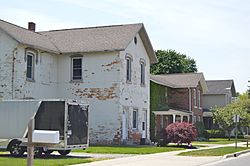Holland, Ohio facts for kids
Quick facts for kids
Holland, Ohio
|
|
|---|---|
|
Village
|
|

Houses on Railroad Street
|
|

Location in Lucas County and the state of Ohio
|
|
| Country | United States |
| State | Ohio |
| County | Lucas |
| Area | |
| • Total | 0.99 sq mi (2.56 km2) |
| • Land | 0.99 sq mi (2.56 km2) |
| • Water | 0.00 sq mi (0.00 km2) |
| Elevation | 637 ft (194 m) |
| Population
(2020)
|
|
| • Total | 1,820 |
| • Estimate
(2023)
|
1,794 |
| • Density | 1,842.11/sq mi (711.52/km2) |
| Time zone | UTC-5 (Eastern (EST)) |
| • Summer (DST) | UTC-4 (EDT) |
| ZIP code |
43528
|
| Area code(s) | 419 |
| FIPS code | 39-35882 |
| GNIS feature ID | 2398524 |
| Website | http://www.hollandohio.com/ |
Holland is a small village in Ohio, United States. It is located in Lucas County, near the city of Toledo. In 2020, about 1,664 people lived there.
Contents
Discovering Holland's Past
The village of Holland has had a few different names over the years. Its very first name was Drakes. This name might have come from a family or because many geese flew over the area.
Later, the area was called Hardy. This name probably came from Samuel Hardy. He was an important person who signed a document with Thomas Jefferson and others. This document gave land in the northwest territories from Virginia to the U.S. government. Samuel Hardy was also part of the Continental Congress.
How Holland Got Its Name
People have different ideas about how Holland got its name. Some thought it was because ditches dug in the 1850s to drain swamp water looked like the canals in the country of Holland. Others believed it was named after the many Dutch people living there. However, early settlers were mostly from New England and New York.
The most likely story is about Franklin Hall, an early house builder. When he planned the land for his houses, he wanted to call it Hall Land. The story says a clerk changed the "a" to an "o" and removed one "l", making it "Holland".
The Arrival of Trains
On May 22, 1852, the first train traveled between Toledo and Chicago. This train ran on two different railroad lines. A few years later, these railroads joined together. The "Air Line" then carried people and goods from Toledo to Elkhart, Indiana.
By 1860, railroad records showed a station in the Holland area, even though it didn't have a name yet. By 1880, Holland had 230 people. The amount of freight (goods) shipped from Holland grew almost 20 times. The number of passengers also increased by about 400% from 1860 to 1880.
Early Development of the Village
In the early 1860s, two important people helped develop Holland. Robert Clark started building on land north of the railroad. Franklin Hall built houses south of the railroad. Today, streets in those areas are named Clark Street and Hall Street, honoring them.
Exploring Holland's Geography
Holland is a small village. According to the United States Census Bureau, the village covers about 0.99 square miles (2.56 square kilometers). All of this area is land.
Understanding Holland's Population
| Historical population | |||
|---|---|---|---|
| Census | Pop. | %± | |
| 1880 | 95 | — | |
| 1930 | 503 | — | |
| 1940 | 607 | 20.7% | |
| 1950 | 714 | 17.6% | |
| 1960 | 924 | 29.4% | |
| 1970 | 1,108 | 19.9% | |
| 1980 | 1,048 | −5.4% | |
| 1990 | 1,210 | 15.5% | |
| 2000 | 1,306 | 7.9% | |
| 2010 | 1,764 | 35.1% | |
| 2020 | 1,664 | −5.7% | |
| 2023 (est.) | 1,794 | 1.7% | |
| U.S. Decennial Census | |||
Population Details from 2010
In 2010, there were 1,764 people living in Holland. These people lived in 749 households. About 430 of these households were families. The village had about 1,782 people per square mile.
Most people in Holland were White (84.1%). About 10.4% were African American, and 2.9% were Asian. About 4.0% of the population identified as Hispanic or Latino.
In 2010, 26.8% of households had children under 18. Many households (44.3%) were married couples living together. The average household had 2.23 people. The average family had 2.96 people.
The average age in Holland was 45.2 years. About 21% of residents were under 18. About 23% were 65 years old or older. More females (54.1%) lived in Holland than males (45.9%).
Education in Holland
Holland is home to Springfield High School. This school is part of the Springfield Local Schools district. The village also has a public library. It is a branch of the Toledo-Lucas County Public Library.
Famous People from Holland
Some notable people have connections to Holland:
- Alexander A. Drabik: The first American soldier to cross the Rhine River into Germany during World War II.
- Joe the Plumber: A well-known conservative activist and commentator.
- Rick Upchurch: A former professional football player for the NFL's Denver Broncos.
See also
 In Spanish: Holland (Ohio) para niños
In Spanish: Holland (Ohio) para niños

